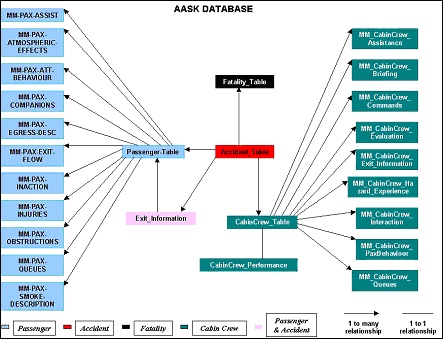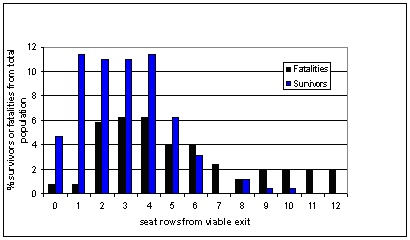The Aircraft Accident Statistics and Knowledge (AASK) database
This project concerns the development of the AASK V4.0 database, a project sponsored by the UK CAA. AASK is the Aircraft Accident Statistics and Knowledge database, which is a repository of survivor accounts from aviation accidents. The AASK database is a unique resource containing data from over 2000 passenger and crew accounts from 105 survivable accidents. The data in AASK is extracted from accident investigation transcripts supplied by the Air Accident Investigation Branch in the UK, the National Transportation Safety Board in the US and the Australian ATSB.
Its main purpose is to store observational and anecdotal data from the actual interviews of the occupants involved in aircraft accidents. The unique database has wide application to aviation safety analysis, being a source of factual data regarding the evacuation process. It is also key to the development of aircraft evacuation models such as airEXODUS, where insight into how people actually behave during evacuation from survivable aircraft crashes is required.
Data within AASK V4.0 covers the period 04/04/77 – 23/09/99 and consists of:
- 105 accidents,
- 1917 individual passenger records from survivors,
- 155 records referring to cabin crew interview transcripts, and
- 338 records of fatalities (passenger and crew).
AASK is currently available online over the internet at
http://aask.gre.ac.uk.
 |
| Figure 1: Diagram of data relationships in AASK V4.0 |
With the development of AASK V4.0, it is possible to access detailed survivor (passenger and crew) information as well as information concerning fatalities. The cabin crew component has become a significant aspect of the database providing insight into cabin conditions and passenger behaviour as seen from professionally trained cabin specialists. The fatalities component holds data for all fatalities documented in the accident reports while the Seat Plan Viewer graphically displays the starting locations of all the passengers – both survivors and fatalities - as well as the exits used by the survivors.
 |
| Figure 2: The distribution of rows to nearest viable exits for survivors and fatalities |
While AASK contains much data, the majority of this data is qualitative in nature. As such, conclusions drawn from the database must be treated with caution and with full knowledge of the implications of the questions posed and the nature of the data used to provide the responses. However, as more data is added to the database, more confidence in performing quantitative analysis is established.
A considerable proportion of the analysis undertaken with AASK V4.0 was intended to reproduce earlier investigations. To this end the initial analysis undertaken with AASK V4.0 concentrated on eight main areas:
Survival and reply rates,
Age distribution,
Seatbelt difficulty,
Seat Climbing reasons,
Direction and distance travelled,
Exit usage,
Exit availability and
Group Behaviour.
It is reassuring to note that much of this analysis has confirmed earlier analysis performed using smaller data sets.
In addition the analysis was extended to include new aspects of the AASK V4.0 data set not previously reported, with a particular focus on data relating to cabin crew. The cabin crew component of AASK provides a view of the developing evacuation situation as seen by the cabin safety ‘professionals’ that were involved in the accident. As such considerable insight can be gained concerning both passenger behaviour and the effectiveness of both operational procedures and emergency equipment. Several analyses using the cabin crew data are considered, the first attempts simply to identify the number of crew that are available to assist in the evacuation, the second attempts to correlate the number of active crew with the average distance travelled by passengers while the third investigates the frequency of exit and slide malfunction.
In addition to the studies and applications investigated in this report, the AASK system could also be used as an aid to accident investigators during the survivor interview process. The difficulties associated with the collection of data from survivors of aircraft accidents are not easily resolved. However, once survivors have been identified and have agreed to share their experiences, a more thorough and standardised approach could be adopted when eliciting and recording their testimonies. The AASK database provides a possible basis for forming such an approach, and as such, also provides a useful framework for the purposes of cross-accident analysis. This type of analysis is vital if trends in passenger behaviour are to be understood and ultimately used to improve passenger safety.
While AASK was originally conceived as a tool to assist in the development of aircraft evacuation models, its uses go far beyond this. AASK is shedding light on what really happens during aircraft emergency evacuations and as such is helping to dispel some of the myths that pervade aviation safety. AASK can also be used to assist in setting up plausible and realistic scenarios for use in performance based analysis of aircraft evacuation capabilities.
Reference:
See publications # 160, 159, 143, 131, 109, 104.

